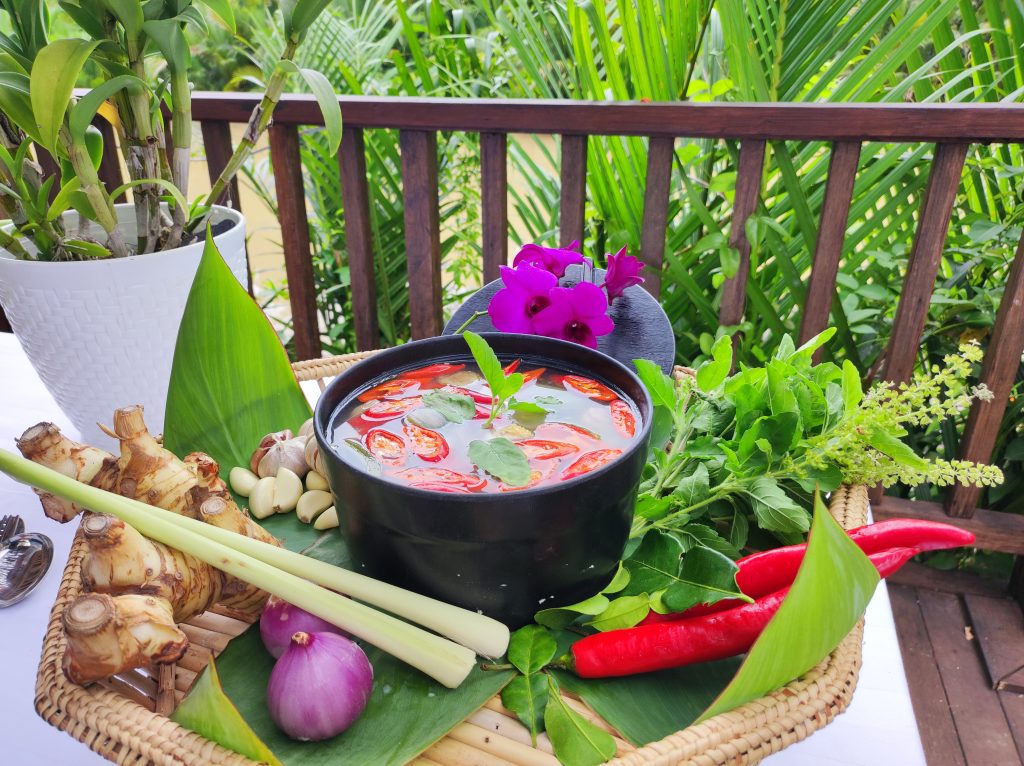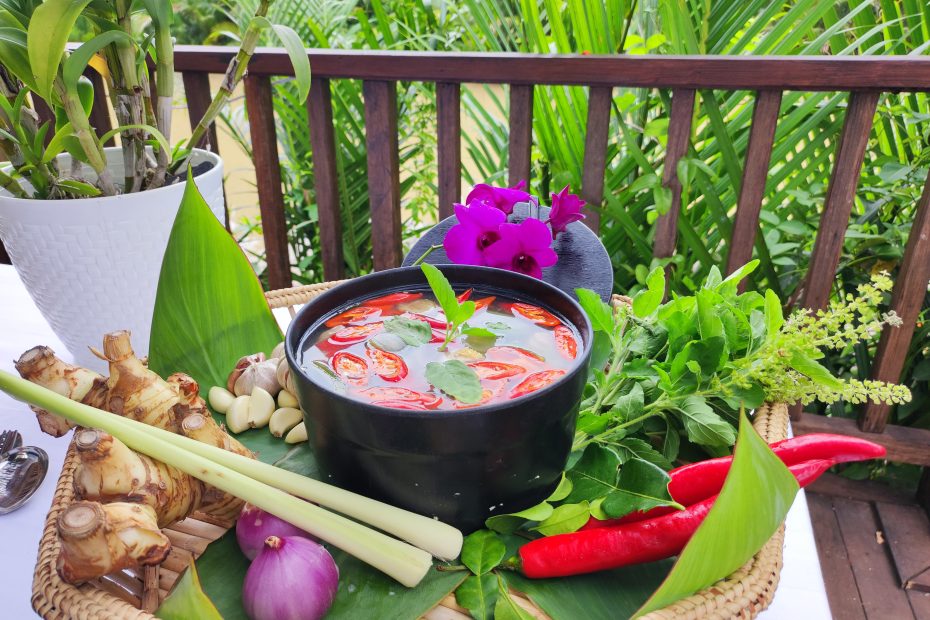The culinary landscape of Cambodia is a treasure trove of flavors, history, and cultural diversity. From vibrant markets to street food stalls, Cambodian cuisine offers a tantalizing journey through the country’s rich history and diverse influences. Here’s everything you need to know about Cambodian cuisine, from its traditional dishes to its unique flavors and fascinating history.
Interesting Facts about Cambodian Cuisine:
Cambodian cuisine is often described as a symphony of flavors, balancing sweet, sour, salty, and bitter elements. What makes it even more intriguing are the unique ingredients like prahok (fermented fish paste), kroeung (a spice paste), and the emphasis on fresh herbs.

Cambodian Cuisine From Kampot Tropical Village
1. Harmony of Flavors
Cambodian cuisine is renowned for its balance of flavors, harmonizing sweet, sour, salty, and bitter tastes within a single dish. This unique combination creates a symphony of sensations that dance on the taste buds.
2. Prahok: A Bold Staple
Prahok, a pungent fermented fish paste, is a staple in Cambodian kitchens. It serves as a base for numerous dishes, contributing a deep umami flavor that’s both distinctive and essential to many recipes.
3. Rice, the Heartbeat
Rice is not just a side dish in Cambodia—it’s the centerpiece of most meals. Cambodian cuisine revolves around the art of rice cultivation and preparation, with different varieties used for specific dishes.
You may check: Cambodian Rice: The Heart of Cambodian Cuisine
4. Kroeung: The Aromatic Spice Paste
Kroeung is a fragrant blend of fresh herbs and spices that forms the foundation of many Cambodian dishes. Its mixture of lemongrass, galangal, turmeric, garlic, shallots, and other spices creates a flavorful base for curries and stews.
5. Coconut, a Versatile Ingredient
Coconut plays a versatile role in Cambodian cuisine. From coconut milk-based curries to desserts and beverages, this tropical fruit adds a creamy richness to various dishes.
6. Farm-to-Table Philosophy
Cambodian cuisine’s emphasis on fresh, local ingredients aligns with a farm-to-table approach. Seasonal produce, herbs, and locally sourced meats contribute to the authenticity of dishes.
7. Balanced Nutrition
Khmer cuisine embodies the concept of balanced nutrition, with dishes artfully combining proteins, carbohydrates, and a medley of fresh vegetables and herbs. This balance ensures that meals provide sustained energy and nourishment.
8. Sweet Delicacies
Cambodian desserts are a delightful indulgence, often featuring coconut, sticky rice, and fresh fruits. Num Kachay (deep-fried glutinous rice flour balls) and Num Kom (rice pudding cake) are among the sweet treats that satisfy the palate.
You may check: Best Cambodian Cakes: A Journey of Sweet Discoveries
9. Nurturing Tradition
Efforts are underway to preserve and promote Cambodian culinary traditions. Cooking classes, culinary tours, and initiatives to pass down recipes ensure that the legacy of Cambodian cuisine continues to thrive.
10. Fusion of Influences
Cambodian cuisine is a reflection of the nation’s historical interactions with neighboring countries, such as Thailand, Vietnam, and China. These influences have shaped and enriched the flavors found in Cambodian dishes.
You may check: Best Cambodian Foods You Must Try
Cambodia’s Traditional Food
Traditional Cambodian food reflects the country’s agrarian heritage. Dishes like Amok, a fragrant fish curry steamed in banana leaves, and Bai Sach Chrouk, grilled pork over rice, showcase the simple yet impactful use of local ingredients and spices.
The Most Popular Food in Cambodia
Among the most beloved Cambodian dishes is Num Banh Chok, a delicacy featuring rice noodles topped with a fish-based curry sauce and fresh vegetables. It’s a comfort food that captures the essence of Khmer cuisine.
What’s Unique About Cambodian Food
Cambodian cuisine is distinct for its ability to merge traditional Khmer flavors with influences from neighboring countries, such as Thailand, Vietnam, and China. This fusion creates a culinary tapestry that’s both familiar and surprising, offering an array of dishes that cater to different palates.
The History of Cambodian Cuisine
The history of Cambodian cuisine is closely intertwined with the country’s cultural evolution and historical events. The famed Angkor Wat, an ancient temple complex, not only served as a religious center but also influenced the culinary practices of the region.
A Cultural Tapestry: Influences and Ingredients
1. Khmer Influence
Khmer cuisine is deeply rooted in Cambodia’s history. Dishes like Samlor Machu Trey, a sour fish soup, and Kuy Teav, a noodle soup, reflect the flavors and ingredients that have been cherished for generations.
2. Colonial Legacy
Cambodia’s history as a French protectorate has left an indelible mark on its cuisine. Baguettes, coffee, and even certain desserts like Num Pang—a type of sandwich—bear the influence of the French colonial era.
3. Regional Diversity
Different regions within Cambodia contribute their own unique flavors to the culinary landscape. Coastal areas boast seafood-centric dishes, while inland regions feature hearty stews and grilled meats.
Street Food and Markets: The Sweetheart of Cambodian Cuisine
Cambodia’s street food scene is a vibrant mosaic of flavors. Markets like Phsar Thmey in Phnom Penh and Psar Chaa in Siem Reap offer a sensory overload of aromas and colors, where vendors dish out delicacies like skewered meats, fresh fruits, and fried snacks.
Preservation and Progression: Navigating the Culinary Future
1. Culinary Revival
Efforts are underway to preserve and revitalize traditional Khmer recipes. Cooking classes, culinary schools, and initiatives to document and share traditional dishes are contributing to the revival of authentic Khmer cuisine.
2. Fusion and Modernization
While preserving tradition is vital, Khmer cuisine is also evolving to meet modern tastes and preferences. Upscale restaurants and contemporary interpretations of classic dishes offer a balance between tradition and innovation.
3. Sustainable Practices
Cambodia’s agricultural heritage influences the culinary emphasis on locally sourced, fresh ingredients. Sustainable practices and a connection to the land continue to shape the way Khmer food is prepared and enjoyed.
4. Global Recognition
Khmer cuisine’s unique flavors and cultural significance are gaining recognition on the global culinary stage. As travelers and food enthusiasts explore Cambodia’s culinary treasures, Khmer food gains appreciation beyond its borders.
You may check: Khmer Home Cooking Recipe for Australia’s Best Pie
Final Thought: A Flavorful Legacy
Cambodian cuisine is not merely about satiating hunger; it’s a journey through history, culture, and tradition. With its fusion of influences, unique flavors, and a commitment to preserving its heritage, Cambodian cuisine stands as a testament to the nation’s resilience, creativity, and boundless love for food. So, whether you’re savoring a fragrant curry or dipping into a bowl of noodles, every bite tells a story of Cambodia’s past, present, and future.
In recent years, there has been a concerted effort to preserve and promote Cambodian culinary heritage. Initiatives focus on passing down traditional recipes, reviving forgotten dishes, and ensuring that the younger generation continues to embrace their cultural culinary roots.



